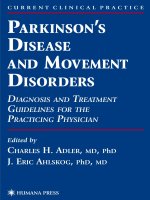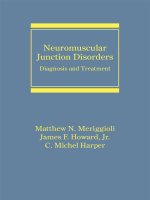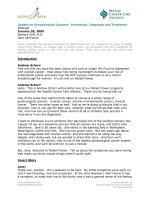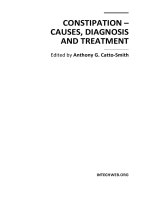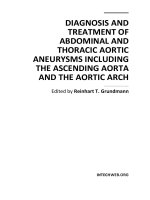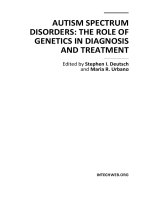Neuromuscular Junction Disorders Diagnosis and Treatment ppt
Bạn đang xem bản rút gọn của tài liệu. Xem và tải ngay bản đầy đủ của tài liệu tại đây (2.4 MB, 319 trang )
Neuromuscular
Junction Disorders
Diagnosis and Treatment
Matthew
N.
Meriggioli
Rush- Presbyterian-St. Luke’s Medical Center
Chicago, Illinois,
U.S.A.
James
E
Howard,
Jr.
University
of
North Carolina at Chapel Hill
Chapel Hill, North Carolina,
U.S.A.
C.
Michel Harper
Mayo Clinic Foundation
Rochester, Minnesota,
U.S.A.
MARCEL
MARCEL DEKKER, INC.
DEKKER
NEW
YORK
BASEL
Although great care has been taken to provide accurate and current information,
neither the author(s) nor the publisher, nor anyone else associated with this publica-
tion, shall be liable for any loss, damage, or liability directly or indirectly caused or
alleged to be caused by this book. The material contained herein is not intended to
provide specific advice or recommendations for any specific situation.
Trademark notice: Product or corporate names may be trademarks or registered trade-
marks and are used only for identification and explanation without intent to infringe.
Library of Congress Cataloging-in-Publication Data
A catalog record for this book is available from the Library of Congress.
ISBN: 0-8247-4079-3
This book is printed on acid-free paper.
Headquarters
Marcel Dekker, Inc., 270 Madison Avenue, New York, NY 10016, U.S.A.
tel: 212-696-9000; fax: 212-685-4540
Distribution and Customer Service
Marcel Dekker, Inc., Cimarron Road, Monticello, New York 12701, U.S.A.
tel: 800-228-1160; fax: 845-796-1772
Eastern Hemisphere Distribution
Marcel Dekker AG, Hutgasse 4, Postfach 812, CH-4001 Basel, Switzerland
tel: 41-61-260-6300; fax: 41-61-260-6333
World Wide Web
The publisher offers discounts on this book when ordered in bulk quantities. For more
information, write to Special Sales/Professional Marketing at the headquarters
address above.
Copyright nnn 2004 by Marcel Dekker, Inc. All Rights Reserved.
Neither this book nor any part may be reproduced or transmitted in any form or by
any means, electronic or mechanical, including photocopying, microfilming, and re-
cording, or by any information storage and retrieval system, without permission in
writing from the publisher.
Current printing (last digit):
10987654321
PRINTED IN THE UNITED STATES OF AMERICA
NEUROLOGICAL DISEASE AND THERAPY
Advisory
Board
Louis R. Caplan, M.D.
Professor of Neurology
Harvard University School
of
Medicine
Beth Israel Deaconess Medical Center
Boston
,
Massachusetts
John
C.
Morris, M.D.
Friedman Professor of Neurology
Co-Director, Alzheimer's Disease Research
Center
Washington University School of Medicine
St. Louis, Missouri
Kapil D. Sethi, M.D.
Professor of Neurology
Director, Movement Disorders Program
Medical College of Georgia
Augusta, Georgia
William C. Koller, M.D.
Mount Sinai School of Medicine
New
York,
New
Yoirk
Bruce Ransom, M.D., Ph.D.
Warren Magnuson Professor
Chair, Department of Neurology
University
of
Washington School of
Medicine
Seattle, Washington
Mark Tuszynski, M.D.,, Ph.D.
Associate Professor
of
Neurosciences
Director, Center for Neural Repair
University of California-San Diego
La Jolla, California
1.
Handbook of Parkinson's Disease,
edited by William C. Koller-
2.
Medical Therapy of Acute Stroke,
edited by Mark Fisher
3.
Familial Alzheimer's Disease: Molecular Genetics and Clinical Per-
spectives,
edited by Gary
0.
Miner, Ralph W. Richter, Johln P. Blass,
Jimmie L. Valentine, and Linda
A.
Winters-Miner
4.
Alzheimer's Disease: Treatment and Long-Term Management,
edited by
Jeffrey L. Cummings and Bruce L. Miller
5.
Therapy of Parkinson's Disease,
edited by William C. Koller (and George
Paulson
6.
Handbook
of
Sleep Disorders,
edited by Michael J. Thorpy
7.
Epilepsy and Sudden Death,
edited by Claire M. Lathers and Paul
L.
Schraeder
8.
Handbook of Multiple Sclerosis,
edited by Stuart
D.
Cook
9. Memory Disorders: Research and Clinical Practice,
edited by Takehiko
Yanagihara and Ronald C. Petersen
10.
The Medical Treatment
of
Epilepsy,
edited by Stanley R. Resor, Jr., and
Henn Kutt
11.
Cognitive Disorders: Pathophysiology and Treatment,
edited by Leon J.
Thal, Walter
H.
Moos,
and Elkan R. Gamzu
12.
Handbook
of
Amyotrophic Lateral Sclerosis,
edited by Richard Alan
Smith
13.
Handbook
of
Parkinson's Disease: Second Edition, Revisled and Ex-
panded,
edited by William C. Koller
14. Handbook
of
Pediatric Epilepsy,
edited by Jerome V. Murphy and ferey-
doun Dehkharghani
15. Handbook
of
Tourette's Syndrome and Related Tic and Behavioral
Disorders,
edited by Roger Kurlan
16. Handbook
of
Cerebellar Diseases,
edited by Richard Lechtenberg
17. Handbook
of
Cerebrovascular Diseases,
edited by Harold P. Adams, Jr.
18. Parkinsonian Syndromes,
edited by Matthew
B.
Stern and William C.
Koller
19. Handbook of Head and Spine Trauma,
edited by Jonathan Greenberg
20. Brain Tumors: A Comprehensive Text,
edited by Robert A. Morantz and
John W. Walsh
21. Monoamine Oxidase Inhibitors in Neurological Diseases,
edited by Abra-
ham Lieberman, C. Warren Olanow, Moussa B. H. Youdim, and Keith
Tipton
22. Handbook of Dementing Illnesses,
edited by John
C.
Morris
23. Handbook of Myasthenia Gravis and Myasthenic Syndromes,
edited by
Robert P. Lisak
24. Handbook
of
Neurorehabilitation,
edited by David
C.
Good and James R.
Couch, Jr.
25. Therapy with Botulinum Toxin,
edited by Joseph Jankovic and Mark
Hallett
26. Principles
of
Neurotoxicology,
edited by Louis W. Chang
27. Handbook of Neurovirology,
edited by Robert R. McKendall and William
G.
Stroop
28. Handbook of Neuro-Urology,
edited by David
N.
Rushton
29. Handbook of Neuroepidemiology,
edited by Philip B. Gorelick and Milton
Alter
30. Handbook of Tremor Disorders,
edited by Leslie
J.
Findley and William
C. Koller
31. Neuro-Ophthalmological Disorders: Diagnostic Work-Up and Management,
edited by Ronald J. Tusa and Steven A. Newman
32. Handbook of Olfaction and Gustation,
edited by Richard L. Doty
33. Handbook
of
Neurological Speech and Language Disorders,
edited by
Howard
S.
Kirshner
34. Therapy
of
Parkinson's Disease: Second Edition, Revised and Ex-
panded,
edited by William C. Koller and George Paulson
35. Evaluation and Management of Gait Disorders,
edited by Barney
S.
Spivack
36. Handbook
of
Neurotoxicology,
edited by Louis W. Chang and Robert
S.
Dyer
37. Neurological Complications
of
Cancer,
edited by Ronald
G.
Wiley
38. Handbook of Autonomic Nervous System Dysfunction,
edited by Amos
D. Korczyn
39. Handbook
of
Dystonia,
edited by Joseph King Ching Tsui and Donald B.
Calne
40.
Etiology
of
Parkinson's Disease,
edited by Jonas
H.
Ellenberg, William C.
Koller, and J. William Langston
41. Practical Neurology of the Elderly,
edited by Jacob
1.
Sage and Margery
H.
Mark
42. Handbook of Muscle Disease,
edited by Russell J. M. Lane
43. Handbook of Multiple Sclerosis: Second Edition, Revised and Expanded,
edited by Stuart
D.
Cook
44. Central Nervous System Infectious Diseases and Therapy,
edited by
Karen L. Roos
45. Subarachnoid Hemorrhage: Clinical Management,
edited by Takehiko
Yanagihara, David G. Piepgras, and John L.
D.
Atkinson
46. Neurology Practice Guidelines,
edited by Richard Lechtenberg and
Henry
S.
Schutta
47. Spinal Cord Diseases: Diagnosis and Treatment,
edited by Gordon L.
Engler, Jonathan Cole, and
W.
Louis Merton
48. Management of Acute Stroke,
edited by Ashfaq Shuaib and Larry B.
Goldstein
49. Sleep Disorders and Neurological Disease,
edited by Antonio Culebras
50.
Handbook of Ataxia Disorders,
edited by Thomas Klockgether
51. The Autonomic Nervous System in Health and Disease,
David
S.
Goldstein
52.
Axonal Regeneration in the Central Nervous System,
edited by Nicholas
A. lngoglia and Marion Murray
53.
Handbook of Multiple Sclerosis: Third Edition,
edited by Stuart
D.
Cook
54. Long-Term Effects of Stroke,
edited by Julien Bogousslavsky
55.
Handbook of the Autonomic Nervous System in Health and Disease,
edited by C. Liana Bolis, Julio Licinio, and Stefan0 Govoni
56.
Dopamine Receptors and Transporters: Function, Imaging, and Clinical
Implication, Second Edition,
edited by Anita Sidhu, Marc Laruelle, and
Philippe Vernier
57. Handbook of Olfaction and Gustation: Second Edition, Revised and Ex-
panded,
edited by Richard L. Doty
58. Handbook of Stereotactic and Functional Neurosurgery, edited by Mi-
chael Schulder
59. Handbook of Parkinson’s Disease: Third Edition, edited by Rajesh Pah-
wa, Kelly
E.
Lyons, and William C. Koller
60.
Clinical Neurovirology,
edited by Avindra Nath and Joseph R. Berger
61. Neuromuscular Junction Disorders: Diagnosis and Treatment,
by Mat-
thew N. Meriggioli, James
F.
Howard, Jr., and C. Michel Harper
Additional Volumes
in
Preparation
Drug-Induced Movement Disorders,
edited by Kapil
D.
Sethi
Foreword
Few practicing neurologists have the energy, commitment and expertise to
complete a substantial monograph. With the publication of this text on
neuromuscular junction disorders, Dr. Matthew Meriggioli has ac hieved this
almost single-handed, aside from the valuable chapters contributed by Dr.
Michel Harper on congenital myasthenia, and by Dr. James Howard on neu-
rotoxicology as it relates to disorders of the neuromuscular junction. Mono-
graphs with a restricted authorship have practical advantages, ensuring a
uniformity of style that readers will here find to be lucid and readily accessible.
Neurologists sometimes feel diffident in managing myasthenic disor-
ders, not only because of the risks of respiratory or bulbar weakness that can
sometimes be life-threatening but also because of the diverse and sometimes
uncertain treatment options. This volume should serve to reassure them. It is
intende d as a clinician’s guide, providing the scientific background with
accompanying clear illustrations before turning to diagnosis and manage-
ment. Readers can be confident that all three authors are themselves clinically
active in the fields they cover, and are thus well qualified to provide an author-
itative work. Indeed, the clinical chapters contain illustrative and informative
case histories from the authors’ own practice. Dr. Meriggioli stresses the
relative lack of evidence-based criteria for many of the treatments used in
myasthenia, but offers balanced recommendations where this is the case. I am
iii
confident that this text will be well received by practising neurologists, and I
warmly commend it.
John New som-Davis, MD FRS
Professor Emeritus, University of Oxford
Department of Clinical Neur ology
Radcliffe Infirmary
Oxford, England
Forewordiv
Preface
Diseases of the neuromuscular junction (NMJ) include a large spectrum of
acquired and inherited disorders mainly characterized by fluctuat ing muscle
weakness and fatigability of ocular, bulbar or limb muscles. Remarkable
progress has been made in our understanding of the pathogenesis of these
disorders in recent years. Furthermore, our ability to diagnose these condi-
tions has improved significantly due to the widespread availability of im-
munologic tests, the use of in vitro electrophysiologic and microstructural
studies, and the refinement of sensitive clinical electrodiagnostic tests of neu-
romuscular transmission. Despite these advances, significant questions re-
main to be answered by the researcher and the clinician, and disagreement
exists amongst specialists regarding therapy an d management of patients.
This lack of a ‘‘consensus opinion’’ makes it difficult for the physician as well
as the physician–trainee to approach these disorders in a systematic fashion.
Unfortunately, existing textbooks covering this topic do not present a de-
tailed and concise resource for diagnosis and management of these patients.
This book is directed toward advanced students, residents and practi-
tioners of neurology, and in particular those who are involved in the
evaluation and care of patients with neuromuscular junction disorders. In
response to the ever-increasing mass of neuroscience information, we have
attempted to present a monograph offering a concise, comprehensive and up-
v
to-date resource covering all aspects of the diagnosis and clinical management
of patients with diseases of the neuromuscular junction with an emphasis on
the clinical aspects of this very interesting group of conditions. The basic
physiology, anatomy, pathophysiology and immunology pertaining to these
diseases are covered in only sufficient depth to allow the clinician to better
understand the mechanism of signs and symptoms, the physiologic basis for
diagnostic tests, and the rationale for specific treatments.
It is important for the reader to realize that there are a number of
approaches to the treatment of the common disorders of neuromuscular
transmission. The reason for this disagreement is apparent when one consid-
ers the surprising paucity of randomized, controlled, prospective therapeutic
studies ad dressing treatment issues in these diseases. This is particularly
apparent in the most common disorder of neuromuscular transmission, myas-
thenia gravis. For this reason, we present the commonly prescribed treatments
for these disorders, the apparent rationale for their use, and the strength of
scientific evidence for efficacy of a certain intervention based on the existing
international literature. We attempt to explain why all physicians do not use a
particular intervention in the same way or in all clinical situations. The reader
may develop his/her own approach based on this evidence. The art of pro-
viding optimal medical care to this group of patients often lies in deciding
when to treat aggressively and when to proceed cautiously and conservatively.
The information provided in this book will assist the clinician in making this
important therapeutic decision by presenting data regarding the natural his-
tory of the disease in question and by detailing the adverse effects of specific
treatment modalities. As in other areas of medicine, therapeutic decision-
making in disorde rs of the NMJ is a risk/benefit assessment.
The book is formatted into two main parts. The first part (Chapters 1–3)
covers the basic anatomy, physiology, pathophysiology, and diagnosis of the
NMJ. The features of presynaptic, synaptic and postsynaptic disorders of the
NMJ are discussed in general as an introduction to the more specific coverage
of the individual disorders. A brief coverage of the immunology relevant to the
immune-mediated disorders of the NMJ is also presented. Part I ends with a
discussion of the diagnostic approach to NMJ disorders including immuno-
logic, pharmacologic and electrophysiologic testing. The information pre-
sented in Part I provides a back ground for understanding concepts presented
in Part II. Part II is comprised of the different individual disorders of neuro-
muscular transmission. Chapters examining myasthenia gravis, Lambert-
Eaton syndrome, congenital myasthenic syndromes and human botulism,
tetanus and venom poisoning are presented. The final chapter of the book
covers the effects of pharmacologic agents on the NMJ. Tables and cross-
referenced charts are used to facilitate understanding of the information and
to allow for integration of the text.
Prefacevi
It is our hope that this volume will aid students and clinicians to gain a
better understanding of the clinical evaluation, investigation, diagnosis and
treatment of diseases of the NMJ, and that investigators and more experi-
enced clinicians will find it a valuable resource.
Matthew N. Meriggioli
James F. Howard, Jr.
C. Michel Harper
Preface vii
Contents
Foreword iii
Preface v
PART I GENERAL ASPECTS OF DISORDERS OF THE
NEUROMUSCULAR JUNCTION
1. Anatomy and Physiology of the Neuromuscular Junction 1
I. Introduction 1
II. The Neuromuscular Junction: A Specialized Synapse 1
III. Anatomy of the Neuromuscular Junction 3
IV. Physiology of Neuromuscular Transmission 14
References 30
2. Pathophysiology of Neuromuscular Junction Disorders 35
I. Introduction 35
II. Prejunctional (Neurogenic) Neuromuscular
Transmission Failure 38
III. Presynaptic Disorders 41
IV. Synaptic Disorders 45
V. Postsynaptic Disorders 46
ix
VI. Clinical Correlation 48
VII. Basic Immune Mechanisms in Disorders of the
Neuromuscular Junction 52
VIII. Overview 55
References 55
3. Diagnostic Tests for Neuromuscular Junction Disorders 59
I. Introduction 59
II. Physiology of Neuromuscular Transmission Revisited 59
III. Diagnostic Testing 60
IV. Comparison of Diagnostic Tests in Myasthenia
Gravis 94
V. Overview 94
References 95
PART II DISORDERS OF NEUROMUSCULAR
TRANSMISSION
4. Myasthenia Gravis 101
I. Introduction 101
II. History 102
III. Epidemiology and Natural History 103
IV. Etiology and Immunopathogenesis 104
V. Clinical Presentation 107
VI. Diagnosis 114
VII. Treatment and Manageme nt 116
VIII. Clinical Management in Specific Situations 134
IX. Overview 145
References 146
5. Lambert-Eaton Syndrome 157
I. Introduction 157
II. History 157
III. Epidemiology and Natural History 158
IV. Etiology and Immunopathogenesis 159
V. Clinical Presentation 165
VI. Diagnosis 170
VII. Treatment and Manageme nt 177
VIII. Special Circumstances 183
IX. Overview 184
References 184
Contentsx
6. Congenital Myasthenic Syndromes 191
I. Introduction 191
II. Molecular Basis of Neuromuscular Transmission 192
III. Diagnostic Methods 196
IV. Congenital Myasthenic Syndrome Subtypes 202
References 221
7. The Neurotoxicology of the Neuromuscular Junction 227
I. Introduction 227
II. Clostridial Neurotoxins 227
III. Occupational Neurotoxins 248
References 252
8. Pharmacological Neurotoxicology of Neuromuscular
Transmission 263
I. Introduction 263
II. Pharmacologic Blockade of Neuromuscular
Transmission 263
References 283
Index 291
Contents xi
1
Anatomy and Physiology
of the Neuromuscular Junction
I. INTRODUCTION
Clinicians who regularly care for patients with disorders of the neuromuscular
junction (NMJ) realize the importance of understanding its anatomy and
physiology. A working knowledge of the anatomy and physiology of the
normal NMJ is obviously needed to fully understand the pathophysiology of
disorders affecting this highly specialized structure. In addition, a full
appreciation of its normal function also forms the basis for understanding
the principles underlying diagnostic testing and the mechanisms of certain
therapeutic interventions. A review of the clinically relevant aspects of the
anatomy and physiology of normal neuromusc ular transmission follows. A
number of clinical examples are provided to illustrate the application of ana-
tomic and physiologic concepts to the diagnosis and treatment of patients
with NMJ disease.
II. THE NEUROMUSCULAR JUNCTION:
A SPECIALIZED SYNAPSE
There are two main types of synapses: electrical and chemical. At an electrical
synapse, two excitable cells communicate by direct passage of electrical
current between them. At a chemical synapse, an action potential causes a
1
transmitter substance to be released from the presynaptic neuron. The trans-
mitter diffuses across the extracellu lar synaptic space and binds to receptors
on the postsynaptic cell to chan ge the electrical properties of the postsynap-
tic membrane.
The NMJ is a specialized chemical synapse between the axon of a motor
neuron and a somatic muscle fiber. The unique structure and functional
organization of this synapse allows for the process of transmitting an
electrical impulse from a motor axon to the muscle fiber it innervates. The
development of sophisticated techniques (including electron microscopy and
in vitro neurophysiologic studies) has considerably enhanced our knowledge
of the microanatomy (Fig. 1.1) and physiology of the NMJ. The NMJ has
Figure 1.1 Electron micrograph of the normal neuromuscular junction. The
presynaptic nerve terminal is on top with the postsynaptic muscle membrane on
the bottom. The short arrow marks a synaptic vesicle that has fused with the
presynaptic membrane and released its contents of acetylcholine molecules into
the synaptic cleft (SC). The secondary synaptic clefts are the spaces between the
junctional folds (JF). A giant synaptic vesicle (G) is seen within the presynaptic
nerve terminal. (From Ref. 1.)
Chapter 12
three basic components (Figs. 1.1 and 1.2): (a) the presynaptic region,
consisting of a terminal branch of a motor axon (the nerve terminal) in which
the neurotransmitter is synthesized, stored, and released; (b) the synaptic
space lined with a basement membrane; and (c) the postsynaptic membrane
which contains the receptor for the neurotransmitter. In human voluntary
muscle, the neurotransmitter is acetylcholine and the receptor is the nicotinic
acetylcholine receptor.
III. ANATOMY OF THE NEUROMUSCULAR JUNCTION
A. The Presynaptic Region
Each motor neuron in the brainstem and spinal cord gives rise to an axon that
branches distally to provide a single nerve terminal to each of the muscle fibers
it innervates. (Fig. 1.3) (1). The motor neuron and the muscle fibers it inner-
vates are collectively known as the motor unit. Each muscle fiber is innervated
by only one motor neuron, but any single motor neuron may innervate
multiple muscle fibers. In humans, an important exception to this rule is the
extraocular muscles in which single muscle fibers may receive m ultiple
innervation. This may play a role in the increased susceptibility of these
muscles to certain disorders of neuromuscular transmission, such as myas-
thenia gravis (Chapter 4).
Nerve terminals are highly specialized regions of the motor axon. An
action potential originating in the brainstem or spinal cord propagates to the
nerve terminal, where it sets into motion a complex chain of events resulting
Figure 1.2 Diagrammatic representation of Fig. 1.1 illustrating the components of
the neuromuscular junction: (1) the presynaptic nerve terminal, (2) the synaptic
space, and (3) the postsynaptic muscle membrane.
Anatomy and Physiology of Neuromuscular Junction 3
in a 1000-fold increase in the rate of release of the neurotransmitter,
acetylcholine (ACh). Near the NMJ, the motor nerve loses its myelin sheath
and divides into fine terminal branches. As a terminal branch of an axon
nears the muscle fiber, it expands into a presynaptic terminal bouton that
lies in a depression in the muscle cell membrane. The terminal nerve fiber is
surrounded by a sheath of epithelial cells (Henle’s sheath), which also ends
abruptly a short distance from the NMJ (2). The distal bulb of the nerve
terminal is unmyelinated, but is ‘‘capped’’ by a Schwann cell (Fig. 1.4)
which, in addition to its involvement in the formation of the nerve myelin
sheath, may play an important role in synaptic maintenance and repair (3).
A basement membrane overlies the Sc hwann cell laterally and becomes con-
tinuous with the basement membrane of the muscle fiber.
The nerve terminal contains a number of subcellular components. Since
the primary function of the nerve terminal is to synthesize and release ACh,
the enzymes and other machinery necessary for these functions are present
within the nerve terminal. These include numerous mitochondria needed to
meet the considerable metabolic demands of transmitter synthesis and
Figure 1.3 The motor unit consists of a motor neuron, its axon, and the muscle
fibers innervated by that axon. A single anterior horn cell motor neuron gives rise to
distal branches each supplying innervation to a single muscle fiber. Each muscle
fiber receives innervation from one motor neuron (with rare exceptions; see text).
The most distal aspect of the individual axonal branches is termed the nerve
terminal and composes the presynaptic region of the neuromuscular junction.
Chapter 14
release, as well as microtubules and microfilaments (4,5). The nerve terminal
also contains the enzyme choline acetyltransferase, which is necessary for the
synthesis of ACh (1).
The most important of the subcellular components of the nerve terminal
are the synaptic vesicles, which are membrane-bound, smooth-surfaced struc-
tures contai ning the ACh molecules (1,6). The ACh molecules are synthes ized
in the nerve terminal, and packaged and stored in the synaptic vesicles. A
single nerve terminal has approximately 200,000 synaptic vesicles (7). The
amount of ACh in a vesicle constitutes a basic unit or quantum of neurotrans-
mitter. One quantum of ACh is defined as the number of transmitter mole-
cules contained in a single vesicle (about 6000–10,000 ACh molecules) (1).
The synaptic vesicles in the nerve terminal are arranged in at least two
pools: the readily releasable pool and the reserve or storage pool. The synaptic
vesicles comprising the readily releasable pool are aligned near release sites in
the nerve terminal. These release sites are called the active zones and lie in
direct opposition to the ACh receptors (AChRs) on the postsynaptic muscle
membrane (Fig. 1.5) (8,9). When the vesicles fuse with the presynaptic nerve
Figure 1.4 Diagrammatic representation of the major components of the mamma-
lian neuromuscular junction. The nerve terminal is unmyelinated but is capped by a
Schwann cell. It is directly aligned with the endplate region of a muscle fiber. A
basement membrane overlies the Schwann cell laterally and becomes continuous
with the basement membrane of the muscle fiber. The endplate region of the muscle
fiber is thrown into a number of folds (junctional folds), with the acetylcholine
receptors located on the crests of these folds.
Anatomy and Physiology of Neuromuscular Junction 5
terminal membrane, they release their contents (ACh) into the synaptic cleft
(7–9). As the pool of readily releasable vesicles is depleted, vesicles from the
storage pool are mobilized to the release sites. The physiologic consequences
of this process will be described in further detail below (see Section IV).
Voltage-gated calcium (Ca
2+
) channels are also located in the active
zones (9–11). They appear as double parallel rows of dense intramembrane
particles (Fig. 1.6) by electron microscopy. Each row contains approximately
five channels with 20-nm spacing between rows and 60-nm spacing between
double rows (1,9). This high concentration of calcium channels at the active
zones allows for the rapid increases in calcium concentration in regions where
vesicle fusion occurs. The principal calcium channel type at human NMJs is
the P/Q-type calcium channel (12). These calcium channels are believed to be
the site of immunologic attack in Lambert-Eaton syn drome (Ch apter 5).
Figure 1.5 Organization of the motor endplate region. The sites of release
of acetylcholine (active zones) are directly aligned with the cusps of the folds on
the postsynaptic muscle membrane where the acetylcholine receptors are
concentrated.
Chapter 16
B. The Synaptic Space
The synaptic space is located between the presynaptic nerve terminal mem-
brane and the postsynaptic muscle membrane. It consists of a primary cleft
and a number of secondary clefts (1,13) (Figs. 1.1). The primary clef t is the
space (about 50 nm wide) between the presyn aptic membrane and the
postsynaptic junctional folds. It is bounded laterally by basement membrane.
The secondary clefts are the spaces between the junctional folds on the
postsynap tic memb rane. The synaptic cleft is essentially an extracellular
compartment that is continuous with the external space around the NMJ.
The short expanse of the primary synaptic cleft allows ACh receptors to reside
very near the ACh release sites so that diffusion time across the cleft is short
(see Section IV).
C. The Postsynaptic Region
The postsynaptic region is a highly specialized area of the muscle fiber mem-
brane, which is also known as the endplate. In normal human muscle there is
one endplate per muscle fiber, typically located about halfway along the
Figure 1.6 Freeze-fracture electron microscopy of the presynaptic membrane
revealing scattered integral membrane particles arrayed in double parallel rows
(arrows). These particles correspond to the voltage-gated calcium channels.
(Reproduced from Engel AG, Myasthenia Gravis and Myasthenic Syndromes,
New York: Oxford University Press, 1999.)
Anatomy and Physiology of Neuromuscular Junction 7
